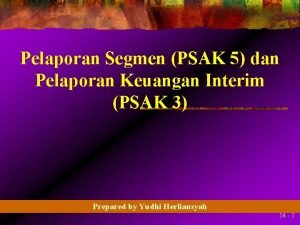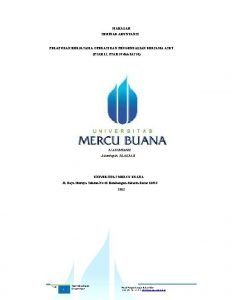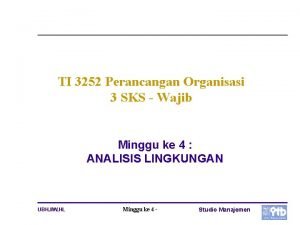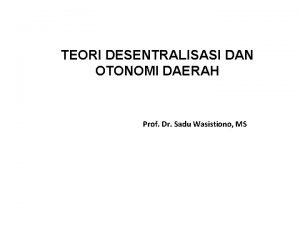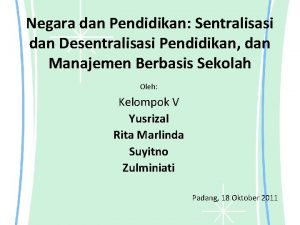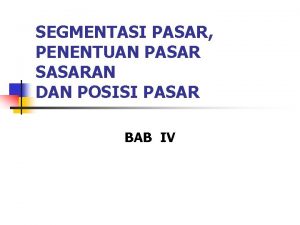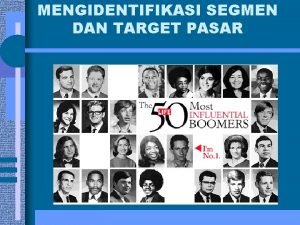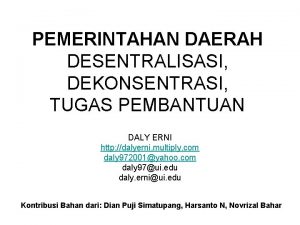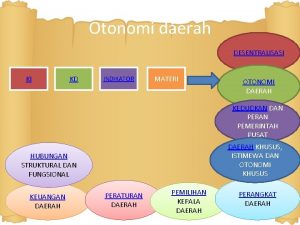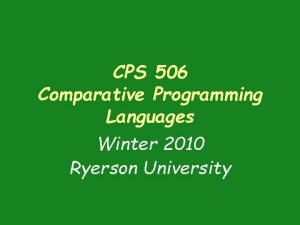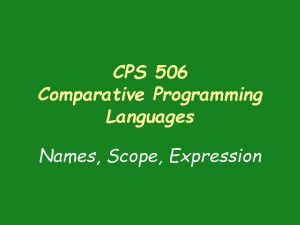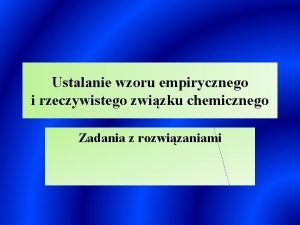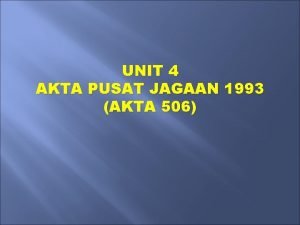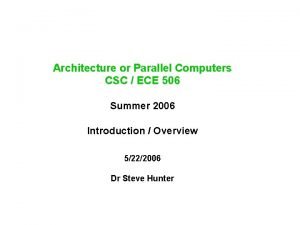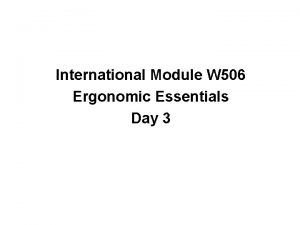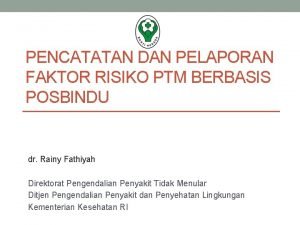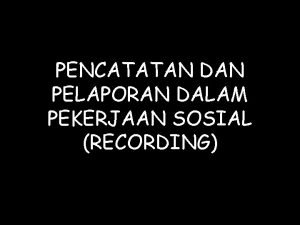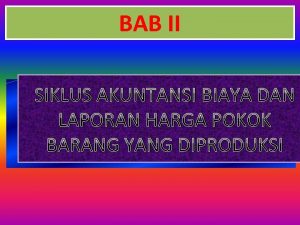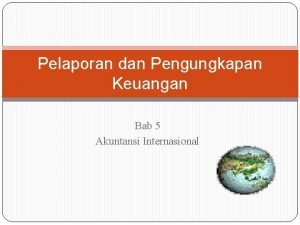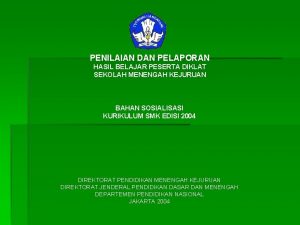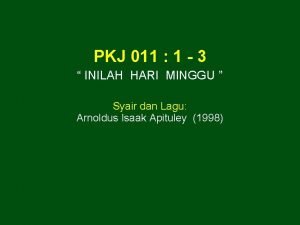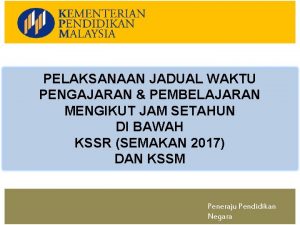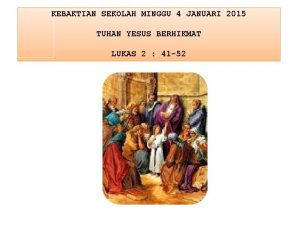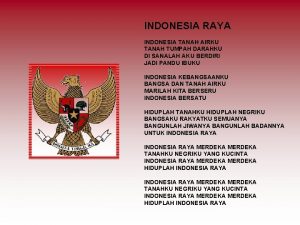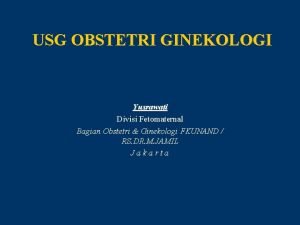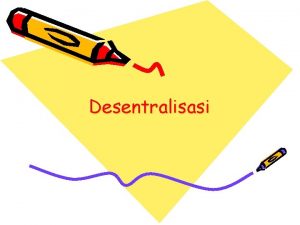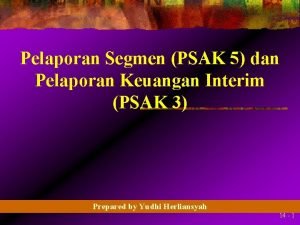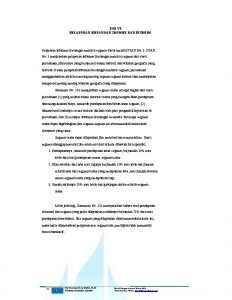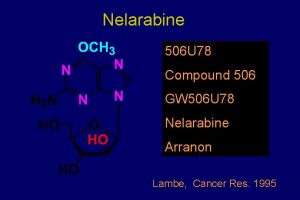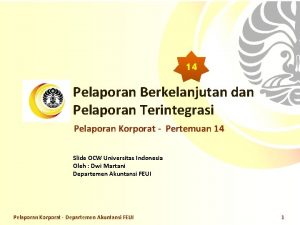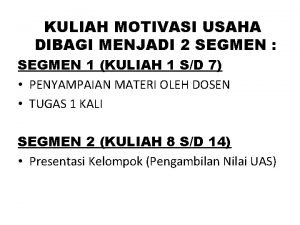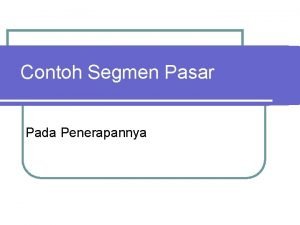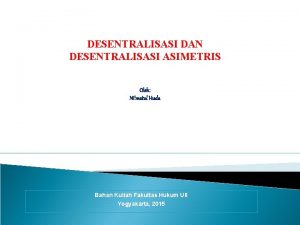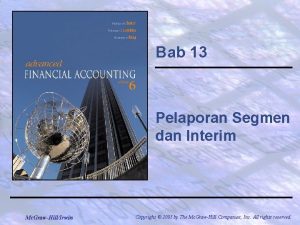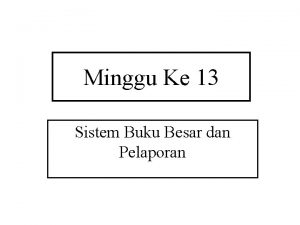Minggu 13 Desentralisasi dan Pelaporan Segmen 506 10








































- Slides: 40

Minggu #13 Desentralisasi dan Pelaporan Segmen 5/06/’ 10

Desentralisasi dalam Organisasi Keuntungan Desentralisasi Lower-level managers Memiliki pengalaman dalam decision-making. Top management Fokus pada strategy. Meningkatkan job satisfaction. Lower-level decision Mendapatkan informasi yang lebih baik Meningkatkan kemampuan dalam evaluasi Mc. Graw-Hill/Irwin © The Mc. Graw-Hill Companies, Inc. , 2003

Desentralisasi dalam Organisasi Lower-level managers Tidak mengambil keputusan dalam “big picture. ” Tujuan Lower-level manager’s Tidak tergambar dalam tujuan organisasi Mc. Graw-Hill/Irwin Kesulitan dalam Koordinasi Pada Manager Otonom Kelemahan Dalam Desentralisasi Kesulitan dalam Menampilkan ide inovatif dalam organisasi © The Mc. Graw-Hill Companies, Inc. , 2003

Desentralisasi dan Pelaporan Segment adalah bagian atau aktifitas yang terdapat dalam organisasi (Struktur Organisasi) yang dikelola oleh manager dalam hal: Biaya (Cost) q Laba (Profit) q Investasi (Investment) An Individual Store Quick Mart A Sales Territory q Mc. Graw-Hill/Irwin A Service Center © The Mc. Graw-Hill Companies, Inc. , 2003

Cost, Profit, and Investments Centers Cost Center A segment whose manager has control over costs, but not over revenues or investment funds. Accounting, personnel, R & D, legal, admin. , Manufacturing, etc. Mc. Graw-Hill/Irwin © The Mc. Graw-Hill Companies, Inc. , 2003

Cost, Profit, and Investments Centers Profit Center A business segment whose manager has control over both costs and revenues, but no control over investment funds. ie. , operations, product lines Mc. Graw-Hill/Irwin Revenues Sales Interest Other Costs Mfg. costs Commissions Salaries Other © The Mc. Graw-Hill Companies, Inc. , 2003

Cost, Profit, and Investments Centers Investment Center A segment whose manager has control over costs, revenues, and investments in operating assets. Divisions, Subsidiaries Mc. Graw-Hill/Irwin Corporate Headquarters © The Mc. Graw-Hill Companies, Inc. , 2003

Segmenting Costs Variable costs are easily traceable to their respective segments Fixed costs must be divided up into those costs that are traceable to segments and those that are not Only those costs that are traceable to a segment will be assigned to a segment Mc. Graw-Hill/Irwin © The Mc. Graw-Hill Companies, Inc. , 2003

Traceable and Common Costs Fixed Costs Don’t allocate common costs. Traceable Common Costs arise because of the existence of a particular segment A cost that supports more than one segment but that would not go away if any particular segment were eliminated. Mc. Graw-Hill/Irwin © The Mc. Graw-Hill Companies, Inc. , 2003

Identifying Traceable Fixed Costs Traceable costs would disappear over time if the segment itself disappeared. No computer division means. . . Mc. Graw-Hill/Irwin No computer division manager. © The Mc. Graw-Hill Companies, Inc. , 2003

Identifying Common Fixed Costs Common costs arise because of overall operation of the company and are not due to the existence of a particular segment. No computer division but. . . Mc. Graw-Hill/Irwin We still have a company president. © The Mc. Graw-Hill Companies, Inc. , 2003

Levels of Segmented Statements Webber, Inc. has two divisions. Let’s look more closely at the Television Division’s income statement. Mc. Graw-Hill/Irwin © The Mc. Graw-Hill Companies, Inc. , 2003

Levels of Segmented Statements Our approach to segment reporting uses the contribution format. Cost of goods sold consists of variable manufacturing costs only. Fixed and variable costs are listed in separate sections. Mc. Graw-Hill/Irwin © The Mc. Graw-Hill Companies, Inc. , 2003

Levels of Segmented Statements Our approach to segment reporting uses the contribution format. Segment margin is Television’s contribution to profits. Mc. Graw-Hill/Irwin © The Mc. Graw-Hill Companies, Inc. , 2003

Levels of Segmented Statements Let’s see how the Television Division/Segment fits into Webber, Inc. Mc. Graw-Hill/Irwin © The Mc. Graw-Hill Companies, Inc. , 2003

Levels of Segmented Statements Mc. Graw-Hill/Irwin © The Mc. Graw-Hill Companies, Inc. , 2003

Levels of Segmented Statements Common costs should not be allocated to the divisions. These costs would remain even if one of the divisions were eliminated. Mc. Graw-Hill/Irwin © The Mc. Graw-Hill Companies, Inc. , 2003

Traceable Costs Can Become Common Costs Fixed costs that are traceable on one segmented statement can become common if the company is divided into smaller segments. Let’s see how this works! Mc. Graw-Hill/Irwin © The Mc. Graw-Hill Companies, Inc. , 2003

Traceable Costs Can Become Common Costs Webber’s Television Division Product Lines Sales Territories Mc. Graw-Hill/Irwin © The Mc. Graw-Hill Companies, Inc. , 2003

Traceable Costs Can Become Common Costs We obtained the following information from the Regular and Big Screen segments. Mc. Graw-Hill/Irwin © The Mc. Graw-Hill Companies, Inc. , 2003

Traceable Costs Can Become Common Costs Fixed costs directly traced to the Television Division $80, 000 + $10, 000 = $90, 000 Mc. Graw-Hill/Irwin © The Mc. Graw-Hill Companies, Inc. , 2003

Traceable Costs Can Become Common Costs The remaining $10, 000 cannot be traced to either the Regular or Big Screen product lines. Mc. Graw-Hill/Irwin © The Mc. Graw-Hill Companies, Inc. , 2003

Segment Margin Profits The segment margin is the best gauge of the long-run profitability of a segment. Mc. Graw-Hill/Irwin Time © The Mc. Graw-Hill Companies, Inc. , 2003

Hindrances to Proper Cost Assignment The Problems Omission of some Value-chain costs in the assignment process, Upstream & downstream Assignment of costs to segments that are really common costs of the entire organization. The use of inappropriate methods for allocating costs among segments, ie, Sales, or DL in automated plant Mc. Graw-Hill/Irwin © The Mc. Graw-Hill Companies, Inc. , 2003

Omission of Costs assigned to a segment should include all costs attributable to that segment from the company’s entire value chain Business Functions Making Up The Value Chain R&D Product Design Mc. Graw-Hill/Irwin Customer Manufacturing Marketing Distribution Service © The Mc. Graw-Hill Companies, Inc. , 2003

Inappropriate Methods of Allocating Costs Among Segments Arbitrarily dividing common costs among segments Inappropriate allocation base Failure to trace costs directly Segment 1 Mc. Graw-Hill/Irwin Segment 2 Segment 3 Segment 4 © The Mc. Graw-Hill Companies, Inc. , 2003

Allocations of Common Costs Mc. Graw-Hill/Irwin © The Mc. Graw-Hill Companies, Inc. , 2003

Allocations of Common Costs Allocated on the basis of sales. Hurray, now everything adds up!!! Mc. Graw-Hill/Irwin © The Mc. Graw-Hill Companies, Inc. , 2003

Allocations of Common Costs Whoops, what about the bar? ? ? Mc. Graw-Hill/Irwin © The Mc. Graw-Hill Companies, Inc. , 2003

Return on Investment (ROI) Formula Income before interest and taxes (EBIT) Net operating income ROI = Average operating assets Cash, accounts receivable, inventory, plant and equipment, and other productive assets. Mc. Graw-Hill/Irwin © The Mc. Graw-Hill Companies, Inc. , 2003

Return on Investment (ROI) Formula Regal Company reports the following: Net operating income Average operating assets Sales ROI = Mc. Graw-Hill/Irwin $30, 000 $200, 000 $ 30, 000 $ 200, 000 $ 500, 000 = 15% © The Mc. Graw-Hill Companies, Inc. , 2003

Return on Investment (ROI) Formula Net operating income ROI = Average operating assets Net operating income Margin = Sales Turnover = Average operating assets ROI = Margin Turnover Mc. Graw-Hill/Irwin © The Mc. Graw-Hill Companies, Inc. , 2003

Return on Investment (ROI) Formula ROI = Margin Turnover Net operating income Sales ROI = $30, 000 ROI = $500, 000 × × Sales Average operating assets $500, 000 $200, 000 ROI = 6% 2. 5 = 15% Mc. Graw-Hill/Irwin © The Mc. Graw-Hill Companies, Inc. , 2003

Controlling the Rate of Return Three ways to improve ROI. . . Increase Sales Mc. Graw-Hill/Irwin Reduce Expenses Reduce Assets © The Mc. Graw-Hill Companies, Inc. , 2003

Controlling the Rate of Return Regal’s manager was able to increase sales to $600, 000 which increased net operating income to $42, 000. There was no change in the average operating assets of the segment. Let’s calculate the new ROI. Mc. Graw-Hill/Irwin © The Mc. Graw-Hill Companies, Inc. , 2003

Return on Investment (ROI) Formula ROI = Margin Turnover Net operating income Sales ROI = $42, 000 ROI = $600, 000 × × Sales Average operating assets $600, 000 $200, 000 ROI = 7% 3. 0 = 21% ROI increased from 15% to 21% Mc. Graw-Hill/Irwin © The Mc. Graw-Hill Companies, Inc. , 2003

Criticisms of ROI Management may not know how to increase ROI. Managers often inherit many committed costs over which they have no control. Managers evaluated on ROI may reject profitable investment opportunities for the company (because its bad for their ROI). Mc. Graw-Hill/Irwin © The Mc. Graw-Hill Companies, Inc. , 2003

Criticisms of ROI As division manager at Winston, Inc. , your compensation package includes a salary plus bonus based on your division’s ROI -- the higher your ROI, the bigger your bonus. The company requires an ROI of 15% on all new investments -- your division has been producing an ROI of 30%. You have an opportunity to invest in a new project that will produce an ROI of 25%. As division manager would you invest in this project? Mc. Graw-Hill/Irwin © The Mc. Graw-Hill Companies, Inc. , 2003

Criticisms of ROI Gee. . . I thought we were supposed to do what was best for the company! Mc. Graw-Hill/Irwin As division manager, I wouldn’t invest in that project because it would lower my pay! © The Mc. Graw-Hill Companies, Inc. , 2003

End of Chapter Hal Jazaa’ul Ikhsan Illa Ikhsan Mc. Graw-Hill/Irwin © The Mc. Graw-Hill Companies, Inc. , 2003
 Contoh laporan keuangan segmen
Contoh laporan keuangan segmen Makalah pelaporan segmen dan interim
Makalah pelaporan segmen dan interim Segmen segmen lingkungan organisasi
Segmen segmen lingkungan organisasi Perbedaan desentralisasi dan dekonsentrasi
Perbedaan desentralisasi dan dekonsentrasi Sentralisasi dan desentralisasi manajemen
Sentralisasi dan desentralisasi manajemen Sentralisasi pendidikan
Sentralisasi pendidikan Desentralisasi dan pusat pertanggungjawaban
Desentralisasi dan pusat pertanggungjawaban Faktor segmentasi pasar
Faktor segmentasi pasar Pola seleksi pasar sasaran
Pola seleksi pasar sasaran Pola pemilihan pasar sasaran
Pola pemilihan pasar sasaran Jelaskan desentralisasi menurut amran muslimin
Jelaskan desentralisasi menurut amran muslimin Sistem unit dosis adalah
Sistem unit dosis adalah Arti daerah otonom
Arti daerah otonom Desentralisasi menurut amran muslimin
Desentralisasi menurut amran muslimin New brunswick area code 506
New brunswick area code 506 Cps506
Cps506 Cps506
Cps506 Ustalanie wzoru rzeczywistego i empirycznego
Ustalanie wzoru rzeczywistego i empirycznego Akta 506
Akta 506 Cs 506
Cs 506 Ece 506 ncsu
Ece 506 ncsu 506 é divisível por 11
506 é divisível por 11 Manual handling
Manual handling Pencatatan dan pelaporan posbindu ptm
Pencatatan dan pelaporan posbindu ptm Pencatatan dan pelaporan dalam pekerjaan sosial
Pencatatan dan pelaporan dalam pekerjaan sosial Siklus akuntansi biaya dan pelaporan
Siklus akuntansi biaya dan pelaporan Tren pengungkapan internasional
Tren pengungkapan internasional Penilaian dan pelaporan
Penilaian dan pelaporan Pelaporan kokurikulum
Pelaporan kokurikulum Yeremia 17:5
Yeremia 17:5 Pkj 11 inilah hari minggu
Pkj 11 inilah hari minggu Cara menjadi mc sekolah minggu
Cara menjadi mc sekolah minggu Simulasi jadual waktu 38 minggu
Simulasi jadual waktu 38 minggu Aktiviti galakan membaca di sekolah
Aktiviti galakan membaca di sekolah Kebaktian sekolah minggu
Kebaktian sekolah minggu Indonesia, tanah airku tanah tumpah darahku
Indonesia, tanah airku tanah tumpah darahku Minggu rogate
Minggu rogate Asuhan primer pada bayi 6 minggu pertama
Asuhan primer pada bayi 6 minggu pertama Typography minggu
Typography minggu Kj no 26
Kj no 26 Gambar usg hamil 1 bulan
Gambar usg hamil 1 bulan
